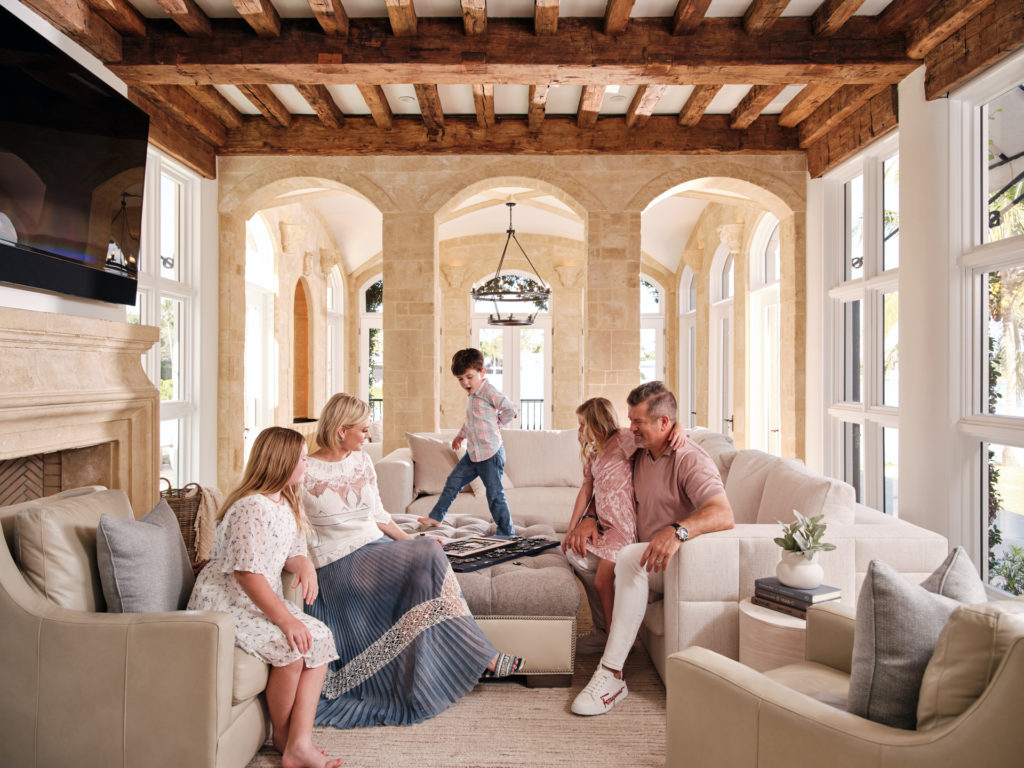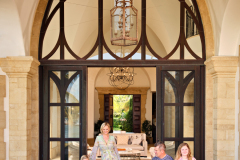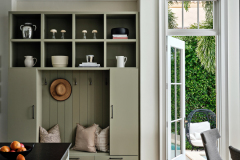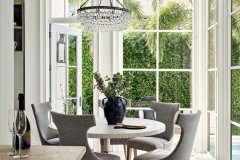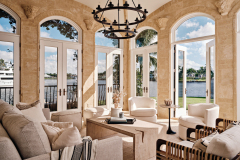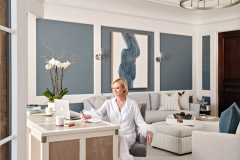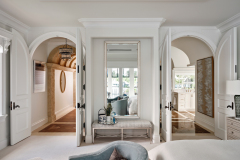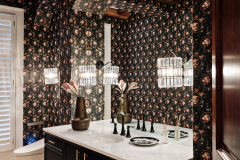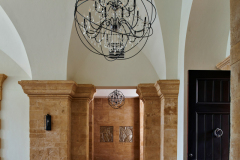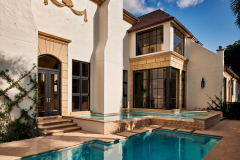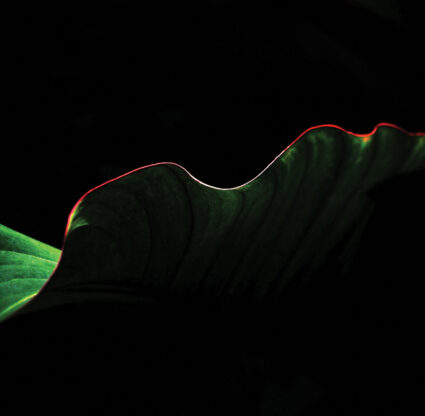John and Amy Quinn never met Lucille “Lu” Drackett, the late Naples philanthropist and former owner of the Keewaydin Club. And yet their lives are intertwined. The Quinns now reside in Lu’s beloved Admiralty Parade home, which she lovingly designed to her exact tastes, using master artisans and drawing inspiration from her many travels.
In other hands, the estate would have likely faced the wrecking ball. But the Quinns, with the help of the home’s original architect, Jeff Harrell of Jeff Harrell Architects, and interior designer Dani Glickson of LVD Spaces, recognized the value in preserving and updating this piece of local history. That’s not to say it didn’t take a lot of imagination and a little convincing.
The 6,637-square-foot, four-bedroom, six-bathroom home was built in 1999 to exacting standards, using some of the latest techniques and materials. Cove lighting, reclaimed beams and precast stonework all feature prominently throughout. A soaring vaulted great room makes quite the impression upon entering, and grand fireplaces, exposed vintage beams, a glorious sunroom and enough stone and millwork to make an Italian countess blush, let you know you’re somewhere special. The home is, like its former owner, a grand dame. “I’ve worked in a lot of homes and this one, from the moment we walked in, I felt this incredible energy,” Dani says. “It felt very special, and I did not want that to go away as we started stripping it down.”
When Lu passed away in 2018, her four sons (Chad, Chris, Spencer and Barrett Ott) listed the home, still filled with the deep colors and heavy furnishings and fixtures Lu hand-selected all those years before. “Our mom loved the design process, and she built the house she wanted. She wasn’t afraid to be different,” Chad says. “Leaving the house intact allowed us to remember her.”
Though plenty of offers came from buyers who planned to tear down the home, the Ott brothers were in no rush to sell and opted to wait for someone who would be mindful with the sanctuary their mother had created. The Quinns, who arrived in Naples from Newport Beach, California, in February 2020 (“Basically, two weeks before the country shut down,” John recalls), initially had the same idea. The couple was at first deterred by the Victorian-style furniture, ornamental architectural features and dark, heavy colors throughout. “It wasn’t us,” Amy says.
In the meantime, various friends of the Quinns also considered buying the property but were equally turned off by its gothic design cues. Everyone agreed the house needed to be torn down. But in 2021, John and Amy Quinn returned for another walk-through—this time, with architect Jeff Harrell in tow. “His houses are very unique,” John says.
Jeff knew the house was worth saving. “Lu loved antiques and art and was well-traveled,” Jeff says. “She wanted an elegant European-style house.” The vaults were an essential detail for Jeff and Lu as a way to make a lofty space more welcoming. “Because it springs from a low level, you don’t feel you are in a cavern,” he says. “That’s the beauty of walking into the space, it feels cozy when you get inside.”
Ultimately, it was interior designer Dani who saw past the Old World quirk and convinced the Quinns of the potential. “You couldn’t build this house today with what they paid for it,” she says. “Many people don’t know what to do with an older house; they think we have to knock it down. We wanted to show you can take something like this and make it work.” Dani was captivated by the home’s history and craftsmanship and the stories of its owner and her famous parties. “Everything was curated to her lifestyle and taste and she loved to entertain,” she says. But Lu’s lifestyle, with her husband gone and all her kids grown and out of the house, was very different from what the Quinns, a family with three kids under the age of 10, would need. “We thought, “How do you make it functional and still honor the original architecture?” Dani recalls.
She saw a clear path forward: They would lighten the palette, recapture the space to make every square inch usable, and allow the architecture to set the stage for a modern-day home unlike any other, with the bones of a French countryside estate and the attitude of a breezy California beach house. “We knew we wanted to go light and bright, because the space was very dark,” she says. “And we knew we couldn’t remove the stone. So, we started thinking of the stone as the primary element and working back from there.”
Dani and the team—which included Newberry North for the majority of the build and D. Garrett Construction for the bathrooms—had four months to transform the stately abode into a welcoming, liveable space for a family of five. “You never know what you’ll find in a home like this, she says. “You have to be patient and amenable that it may not all end up exactly where you wanted.”
The exterior, which was Mediterranean gold, was painted white. Inside, Dani covered the walls with a creamy white, removed excessive moldings and stonework (including a few faux columns scattered about), redid the fireplace’s interiors, cleaned all the Jerusalem stone on the floors and walls, and, where appropriate, painted the mahogany trim on windows, doors and walls a stark, modern black. Dani loved the stately reclaimed wood beams but felt the colors in the home weren’t doing them justice. “The dark paint distracted you and you didn’t look up,” she says. She tested 15 shades of white before landing on the perfect hue to complement the stone and beams: Benjamin Moore Swiss Coffee, diluted to 75 percent.
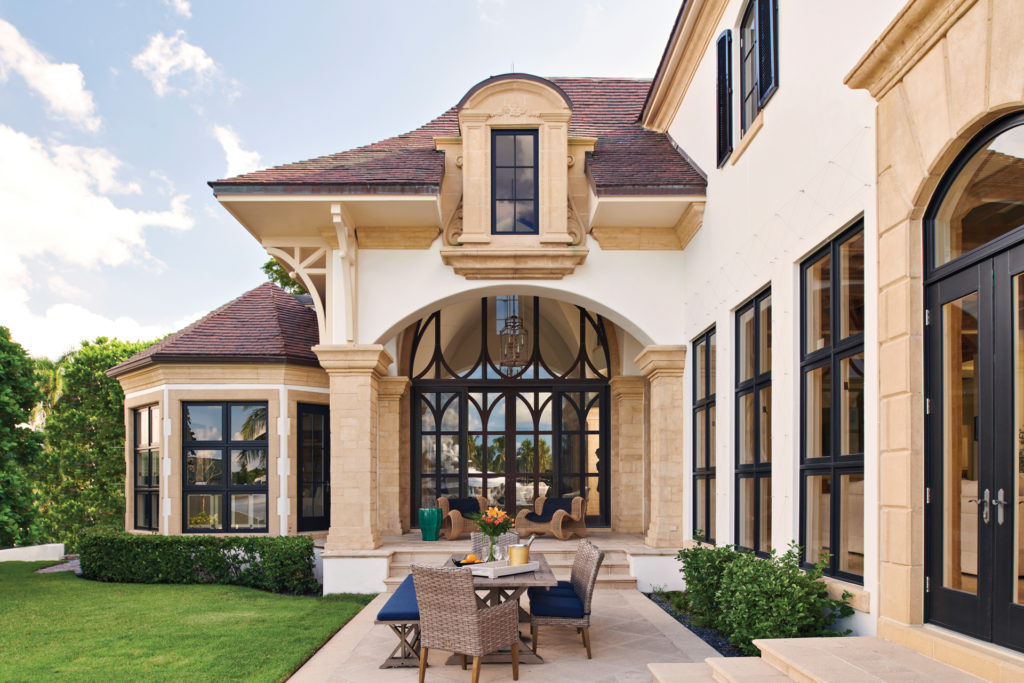
Lighting presented the biggest challenge. The home was dim and needed a lot more light, but whenever the electrician would cut into the ceiling, they’d find trusses, where the fixtures couldn’t go. “We had to come up with a lot of solutions on the fly,” Dani says. Throughout, all the fixtures were replaced, LEDs were added where old halogen bulbs resided, and recessed cans were cut into the ceiling to provide more overhead lighting.
In the dining room, the team got rid of the maroon Venetian plaster and gold candlesticks and added neutral-toned, minimal furnishing and accents, “just to break up the stone a little and balance out the heavier stone and wood,” Dani says. A painting by local artist Kristy Gammill now anchors the space.
The kitchen was surprisingly modern for a 21-year-old home. Other than adding contemporary amenities and a mudroom area (matched closely to the original cabinetry) for backpacks and sundry items, it largely remains the same, with its Dacor appliances and leathered granite island top. “A lot of these things, like leathered finish granite, are back in style but so hard to find, so I said keep it,” Dani says.
The living room’s major transformation involved the television on top of the (working) fireplace. “The fireplace had a top on it with painted mural and doors storing a little tiny TV. And I was like, ‘That’s not going to work for you, John.’ So, we cut the top of the stone off and all that drywall and redid it.” Where they could, furnishings were repurposed from the Quinns’ former home. But Dani had fun adding pieces like the Lazar Industries sofa in the family room with quilting on the back that matches the French pattern of the floors. After the sunroom was painted from its lime green shade, all the furnishings were added new (RH chairs, custom Kelly Wearstler pillows, Dovetail coffee table, Circa chandelier). “This is the best room in the house, where you’re going to sit with your friends and spend all your time—I wanted to maximize the space and not distract from the view with color,” Dani says. “I didn’t want the eye to go anywhere except the view, but I also wanted it to look more than one-dimensional, so we played with tone.”
Upstairs, the primary bedroom had its carpet replaced and heavy gold tapestries and murals gave way to a more calming blue palette. The primary bath was gutted: Out went the big inset double-layer tub; in came new plumping on a platform for a freestanding tub, textured tile and repositioned sprays for the shower, and a double vanity to replace the small, storage-less version that stood there before. The only thing that remains is the floor tile, which “feels like the St. Regis,” Dani says.
While their son Austin’s room needed little work, the other kids’ shared room required a total makeover to make it feel special for two little girls who previously had their own spaces. Unfunctional nooks became arts and crafts stations, reading nooks, and a secret playroom in a tiny sloped former storage area. “We used every inch of this house,” Dani says.
Back downstairs, the den, which Amy uses as her office, was one of the first rooms refinished. “It was dark green with burlap paneling,” John recalls. “We sanded and painted the burlap a Nantucket Blue and the trim white.” They also added cove lighting, updated the sconces and overhead lighting, painted the ceiling all white, and kept the wood flooring. It was an easy upgrade.
Nearby, the powder room is a playful ode to the original design of the home, with its Gucci lion print wallpaper. “Amy let me go wild in here,” Dani says. “The wallpaper nods to the lion details that pop up throughout the home—in the fountain outside, the scones, the fireplace.”
By renovating, the Quinns were in their new home within months. If they had to build new, construction would have taken at least two years. “While some older homes would cost more to renovate and aren’t worth it, there are so many homes here that could be this,” Dani says. “You eliminate so much of Naples’ vibe by knocking down every house. This city, and especially Port Royal, was built in a very special way; why are we just scraping all of that?”
She points to the home’s state after Hurricane Ian and how the property stands unscathed after one of the fifth-largest storms reported in U.S. history: “It’s a testament to the craftsmanship and how meticulously well this home was constructed.”
Photography by Dan Cutrona

